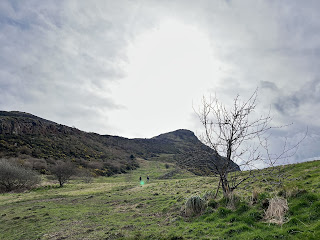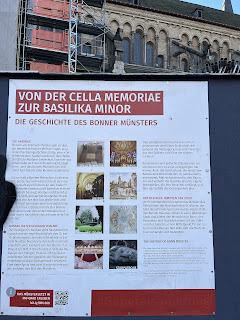Ich bin zurück in Glastonbury. Seit ich im Frühjahr 2014 zum ersten Mal hier war, muss ich immer wieder kommen. Das Städtchen und die Abteiruinen sind für mich so etwas wie ein Sehnsuchtsort geworden. Immer wenn ich ankomme, muss ich zuerst die Abtei besuchen (https://fraumb-far-far-away.blogspot.com/2014/07/glastonbury-abbey.html?m=0) und diesmal besuche ich auch das Museum. Das ist ein großer Raum neben dem Ticketschalter und er gibt einen kurzen Abriss über die Geschichte der Abtei und über die Zeit, als die Abtei keine mehr war.
Sehr aufschlussreich sind die Animationen, die die vormaligen Bauten der Abtei in die ausgegrabenen Ruinen projizieren, so bekommt man eine gute Vorstellung von der Größe der Gebäude und einen Einblick den Alltag eines mittelalterlichen Klosters.
Wie schon erwähnt, habe ich von Glastonbury erfahren durch einen Kriminalroman von Deborah Crombie „Von fremder Hand“, es geht um so alltägliche Dinge wie Unbesonnenheit, Unaufmerksamkeit, Fahrerflucht nach tödlichem Unfall, Lügen und Mord. In einem anderen Handlungsstrang geht es um die Geschichte der Abtei, die einem der Protagonisten durch das automatische Schreiben unterbreitet wird. (Auf diese Weise hatte Frederick Bligh Bond seine Erkenntnisse gewonnen, die zu vielen erfolgreichen Ausgrabungen auf dem Abteigelände führten. Und natürlich wurde er in Schimpf und Schande davon gejagt, als er darüber sprach. Also, Vorsicht, wenn man anders ist, als andere.) Das Medium ist ein Mönch der Abtei, wie bei Bligh Bond auch, der von seinem Leben berichtet.
Er kam als Kind als Schenkung in das Kloster, eine mittelalterliche Sitte, der Kirche etwas zu stiften und meinte, sein Vater hatte im Sinn, die Kirche doppelt zu betrügen, in dem er seinen kränkelnden Sohn schickte, und somit eine nutzlose Spende abgibt und selber nicht mehr für das Kind sorgen muss. Im weiteren Verlauf berichtet der Mönch, dass der Vater nichts von der Heilkunde wusste, die die Mönche praktizieren. Er wuchs zu einem gesunden jungen Mann heran und seine Talente im Schönschreiben und Malen konnten sich entfalten. Darüber erfahren wir auch hier im Museum, es war einer der Dienste an der Gemeinschaft, den die Mönche anboten, die Pflege von Kranken und ein anderes Bild zeigt, einen Mönch beim illustrieren mit Feder, Pinsel und Farbe.
Neben den vielen Stunden, die die Mönche mit Gebet und Gesang verbrachten mussten sie ihre Ländereien verwalten, für ausreichend Nahrung für die Bewohner und Gäste der Abtei sorgen, es wurde gewaschen, genäht, gekocht, Gebäude repariert und viele andere alltägliche Dinge getan.
Das Museum stellt Fragmente der Steinmetzarbeiten aus, die bei den Ausgrabungen gefunden wurden und erklärt die spezielle Architektur, die die großen Türme zu dieser Zeit stabil hielt. Es sind Scherenbögen, ein Strukturelement der englischen Gotik und die bekanntesten gibt es in der Kathedrale von Wells (https://fraumb-far-far-away.blogspot.com/2014/09/die-kirche-mit-den-scherenbogen-wells.html?m=0), aber auch die Abteikirche sah einstmals so aus. Neben den Steinmetzen haben auch die Fliesenhersteller fantastische Arbeit geleistet und einige Beispiele ihrer Kunst kann man im Museum und draußen in der Nähe des Eingangs zum Kirchenschiff sehen. Sie sind zum Schutz abgedeckt, darum habe ich sie dieses Mal erst entdeckt.
Auch für Kinder ist das Museum ein schöner Ort, auf kurzweilige und kindgerechte Art erfahren sie, wie so ein Kloster aufgebaut war, welche Kleidung die Leute trugen, welche Speisen sie aßen und welche Werkzeuge sie benutzt haben.
English version below
I'm back in Glastonbury. Since I was here for the first time in spring 2014, I have to keep coming back. The town and the abbey ruins have become something of a place of longing for me. Whenever I arrive I have to visit the Abbey first (https://fraumb-far-far-away.blogspot.com/2014/07/glastonbury-abbey.html?m=0) and this time I also visit the museum. This is a large room next to the ticket office and it gives a brief outline of the history of the abbey and when the abbey ceased to exist.
The animations that project the abbey's former buildings into the excavated ruins are very revealing, giving you a good idea of the size of the buildings and a glimpse of everyday life in a medieval monastery.
As mentioned, I first heard about Glastonbury through a detective novel by Deborah Crombie, „A Finer End“, about such mundane things as rashness, inattentiveness, hit-and-run after a fatal accident, lies and murder. Another story line deals with the history of the abbey, which is presented to one of the protagonists through the automatic writing. (It was in this way that Frederick Bligh Bond had gained his insights which led to many successful excavations on the abbey site. And of course he was scolded in disgrace for speaking of it. So beware if you are different from others.) The medium is a monk of the abbey, as with Bligh Bond, who tells of his life.
He came to the monastery as a child as a gift, a medieval custom of donating to the church, and said his father had in mind to doubly cheat the church by sending his ailing son, giving a useless donation and himself no longer have to take care of the child. The monk then reports that the father knew nothing about the healing arts that the monks practice. He grew into a healthy young man and his talents in calligraphy and painting were able to develop. We also learn about this here in the museum, it was one of the services to the community offered by the monks, caring for the sick and another picture shows a monk illustrating with a pen, brush and paint.
In addition to the many hours that the monks spent in prayer and song, they had to manage their lands, provide enough food for the residents and guests of the abbey, wash, sew, cook, repair buildings and do many other everyday things.
The museum exhibits fragments of the stone carvings found during the excavations and explains the special architecture that kept the great towers stable at the time. They are scissor arches, a structural element of English Gothic and the most famous are in Wells Cathedral (https://fraumb-far-far-away.blogspot.com/2014/09/the-church-with-the-scissor-arch- wells.html?m=0), but the abbey church once looked like this too. As well as the stonemasons, the tile makers also did a fantastic job and some examples of their art can be seen in the museum and outside near the entrance to the nave. They're covered for protection, so this time I spotted them first.
The museum is also a nice place for children, they learn in an entertaining and child-friendly way how such a monastery was built, what clothes the people wore, what food they ate and what tools they used.





















































